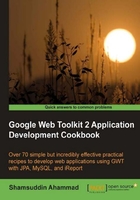
GWT 2 radically improves the web experience for users by using the existing Java tools to build a no-compromise AJAX for any modern browser. It provides a solid platform so that the other great libraries can be built on top of the GWT. Creating web applications efficiently and making them impressive, however, is not as easy as it sounds. Writing web applications for multiple browsers can be quite tasking. In addition, building, reusing, and maintaining large JavaScript code bases and AJAX components can be difficult.
GWT 2 Application Development Cookbook eases these burdens by allowing the developers to build and maintain complex, yet highly efficient JavaScript frontend applications in the Java programming language quickly. It tells you how to make the web experience all the more thrilling and hassle-free by using various tools along with the GWT SDK.
This book starts with developing an application from scratch. Right from creating the layout of the home page to home page elements including left and right sidebars, to placing a tree-like navigational menu, menu bars, tool bars, banners, and footers are discussed with examples.
You will see how to create forms using the Ext GWT library widgets and handle different types of events. Then, you will move on to see how to design a database for sales processing systems, and learn how to create the database in MySQL with the help of easy-to-follow recipes.
One of the interesting topics of this book is using the JPA in GWT. Using the JPA object in GWT is a challenge. To use it perfectly, a mechanism to convert the JPA object into a plain object and vice versa is required. You will see recipes to use entity classes, entity managers, and controller classes in the GWT application. You will efficiently create reports with parameters, variables, and subreports, and get the report output in both HTML and PDF formats using real-world recipes.
You will then learn how to configure the GlassFish server to deploy a GWT application with a database. Finally, you will learn how to trace speed and improve performance in web applications using tracing techniques.
Create impressive web applications with tool bars, menus, multiple windows, and more with this step-by-step guide.
Chapter 1, Setting up the GWT Environment in NetBeans shows which tools and technologies are required to build a web application using GWT, JPA, and iReport in NetBeans. The required installation and configuration of the tools are shown as easy-to-follow recipes.
Chapter 2, Creating Home Page with Panels and Menus creates the layout of the application. It shows how to divide the page into the banner, left and right sidebars, and the center and footer sections.
Chapter 3, Forms with Layout and Widgets includes recipes that show how to use widgets to create forms, sidebars for navigation, tab panel, and so on.
Chapter 4, Handling your First Events includes easy-to-follow recipes that show how to handle the typical GWT events such as button event, field event, menu event, focus event, change event, and so on.
Chapter 5, Creating Database for Sales Processing creates a sample database in MySQL for Sales Processing Systems. To create a database and its tables with the required constraints, easily the uses of MySQL GUI tools have been shown.
Chapter 6, Managing Entities using JPA deals with the Java Persistence API (JPA) framework. It is a framework that is used to manage relational data in Java EE and Java SE applications. JPA provides a Plain Old Java Object (POJO) persistence model for object relational mapping. This chapter shows how to create a database connection, persistence unit, entity classes, and controller classes for the database CRUD operations.
Chapter 7, Communicating with Server using GWT RPC deals with the communication between the client and the server. The recipes in this chapter describe how to use the JPA in the server side and Data Transfer Objects (DTO) in the client side. It discusses how the GWT RPC mechanism allows the server and the client to pass Java objects back and forth.
Chapter 8, Reporting with iReport shows how to use iReport for the reporting solutions in Java web applications. Parameterized reports, subreports, and reports with variables are shown in some recipes. Then, the chapter discusses and shows how to show the created reports as HTML or PDF in the GWT application.
Chapter 9, Deploying a GWT Application includes recipes that show how to build the GWT project for the deployment, and before the deployment, how to create JDBC connection pool and resources in the GlassFish server are given as recipes.
Chapter 10, Using Speed Tracer deals with the extension Speed Tracer. Speed Tracer is a Google Chrome browser extension which is used to identify and fix performance problems in web applications. Installation and use of Speed Tracer for the created GWT applications are shown in this chapter.